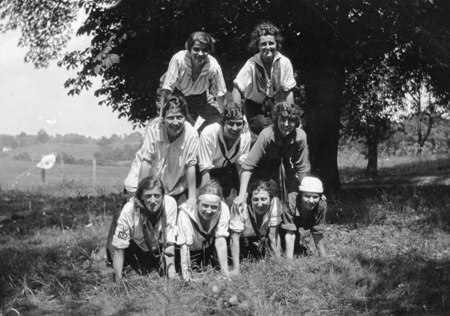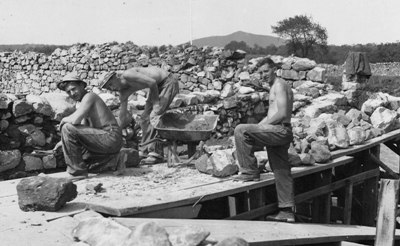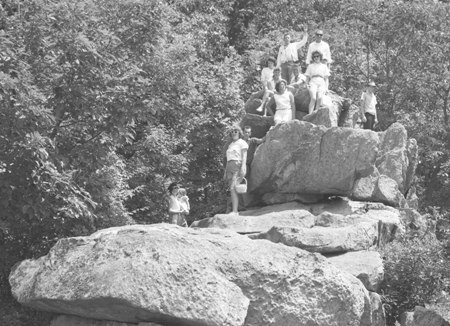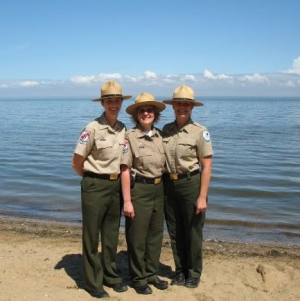 The Maryland Park Service operates one of America’s oldest state park systems. The first state-park land was set aside in 1907 when Catonsville philanthropist John Mark Glenn donated 43 acres of his Catonsville estate to the Maryland Board of Forestry. Thanks to this early start, today most Maryland residents live within 15 miles of a state park.
The Maryland Park Service operates one of America’s oldest state park systems. The first state-park land was set aside in 1907 when Catonsville philanthropist John Mark Glenn donated 43 acres of his Catonsville estate to the Maryland Board of Forestry. Thanks to this early start, today most Maryland residents live within 15 miles of a state park.
For much of the 20th-century, Maryland’s parks were managed together with the state’s forest system—also one of the nation’s oldest. The earliest parks, most notably Patapsco Valley and Fort Frederick, were originally called “forest reserves.” Early on, however, Maryland’s first State Forester Fred W. Besley recognized that some forests were more than places to save trees. Patapsco’s proximity to Baltimore City made it an ideal place to create a new “city park.” Fort Frederick, purchased in 1922, saved the ruins of an important French and Indian War fortification. In fact, nearly all the land the Board of Forestry acquired between 1912 and 1922 was geared towards fostering outdoor recreation and historic preservation.
Like many states, however, Maryland’s park system began to come of age during the 1930s’ Great Depression. Thanks to President Franklin D. Roosevelt’s New Deal, federal money and labor poured into Maryland, and the first truly modern state parks were built. Much of the work was done by young men serving in the Civilian Conservation Corps (CCC). As part of a larger effort to get the nation’s unemployed back to work, the CCC cleared trails, built roads, bridges, shelters and lakes. They rebuilt walls at Fort Frederick, reconstructed the first completed Washington Monument on South Mountain, and built shelters and roads in Patapsco. They also built new parks from the ground-up, including Elk Neck, Gambrill, Millburn Landing (now part of Pocomoke River), Herrington Manor and New Germany.
 Most of Maryland’s state parks were created between 1945 and 1975. Thanks to a prosperous economy and assistance from the federal government, the State Department of Forests and Parks acquired and developed dozens of new parks, including Assateague, Cunningham Falls, Deep Creek Lake, Gathland, Greenbrier, Gunpowder Falls, Janes Island, Martinak, Point Lookout, Rocks, Rocky Gap, Seneca Creek, Susquehanna, Tuckahoe, and many others. Most of these parks protected significant watersheds and natural wonders and saved significant historic sites. Park development was a priority in the 1960s, and many parks saw the creation of picnic areas, beaches, full-service campgrounds, and marinas. These developed parks are still among the most popular and heavily visited today, and remain the backbone of lands managed by the Maryland Park Service.
Most of Maryland’s state parks were created between 1945 and 1975. Thanks to a prosperous economy and assistance from the federal government, the State Department of Forests and Parks acquired and developed dozens of new parks, including Assateague, Cunningham Falls, Deep Creek Lake, Gathland, Greenbrier, Gunpowder Falls, Janes Island, Martinak, Point Lookout, Rocks, Rocky Gap, Seneca Creek, Susquehanna, Tuckahoe, and many others. Most of these parks protected significant watersheds and natural wonders and saved significant historic sites. Park development was a priority in the 1960s, and many parks saw the creation of picnic areas, beaches, full-service campgrounds, and marinas. These developed parks are still among the most popular and heavily visited today, and remain the backbone of lands managed by the Maryland Park Service.
Beginning in the 1970s, park development slowed. Once abundant funding began to dry-up. More importantly, new types of park visitors began to appear. While many people still valued beaches, picnic areas and campgrounds, others looked for places to exercise and find spiritual enlightenment. In response to these changes, many parks began placing more emphasis on building and maintaining trails. In the 1980s and 1990s, new and innovative parks emerged, such as rail trails and water trails. One of the nation’s first rail trails, the Northern Central (now Torrey C. Brown) Rail Trail, opened in 1984.
While park development slowed, thanks to Program Open Space, the parks themselves continued to grow. Many lands, such as Soldiers Delight and North Point, were acquired because of their unique, rare and valuable ecosystems. As a result, Maryland’s state parks, along with its forests and wildlife management areas, are now widely viewed as places that are protected from development, providing a place where wildlife can prosper.
Where did the Maryland Park Service Come From?
The agency that now manages Maryland’s state parks, the Maryland Park Service, is surprisingly new. It was created in 2005. However, it is the latest in a long-line of agencies that have been managing state park land since 1907.
The first agency to manage state parks was the Maryland State Board of Forestry, which was organized in 1906 to acquire, protect and manage state forests and parks. In 1923, the Board of Forestry was reorganized as the State Department of Forestry, and was placed under the control of the University of Maryland, where it would remain until 1941. During this entire period, the forests and parks were managed together by State Forester Fred W. Besley.
 In 1941, the Department of Forestry, along with the state’s other natural resource agencies, was placed under the control of the newly organized Maryland Board of Natural Resources. That year, the agency was renamed the State Department of Forests and Parks. One year later, Joseph F. Kaylor succeeded Besley as State Forester. In 1947, the positions of state forester and department director were separated, and Kaylor became director while Henry C. Buckingham became state forester. Though the state forests and parks would remain under the same management until 1972, they were increasingly operated as separate entities.
In 1941, the Department of Forestry, along with the state’s other natural resource agencies, was placed under the control of the newly organized Maryland Board of Natural Resources. That year, the agency was renamed the State Department of Forests and Parks. One year later, Joseph F. Kaylor succeeded Besley as State Forester. In 1947, the positions of state forester and department director were separated, and Kaylor became director while Henry C. Buckingham became state forester. Though the state forests and parks would remain under the same management until 1972, they were increasingly operated as separate entities.
In 1964, Spencer P. Ellis, a landscape architect, became the first trained park professional to be Director of the Department of Forests and Parks. Under his leadership, park development accelerated.
Five years later, in 1969, the State Department of Forests and Parks was placed under the newly created Maryland Department of Natural Resources (DNR). In 1972, state forests and parks were formally separated, and all state park land was placed under the stewardship of the first Maryland Park Service and its Superintendent, William A. Parr. The separation did not last long.
In 1982, forests and parks were recombined and placed under the management of Donald E. MacLauchlan. Two years later, DNR’s wildlife division was added to create the Maryland Forest, Park & Wildlife Service. This arrangement, too, was short-lived.
In 1991, all state forest and park land was placed under the newly organized Maryland State Forest & Park Service. Headed by Superintendent Rick Barton, this arrangement remained in-place until 2005. That year, the state forests were once again placed under the control of the Maryland Forest Service, which led to the creation of today’s Maryland Park Service.
Today, the Maryland Park Service’s mission is to manage the natural, cultural, historical and recreational resources to provide for wise stewardship and enjoyment by people.
Superintendent's Spotlight
Many people over the years have managed Maryland’s state parks.
- Fred W. Besley (1906-1942)
- Joseph F. Kaylor (1942-1947)
- Karl Pfeiffer (Assistant State Forester) (1936-1954)
- William R. Hall (1954-1956)
- William A. Parr (1956-1964, 1972-1978)
- A. J. Pickall (1964-1968)
- William H. Johnson (1968-1972)
- Donald E. MacLauchlan (1978-1986)
- David Hathway (1986-1990)
- Rick Barton (1991-2007)
- Nita Settina (2008-present)
Milestone Dates in Maryland State Park History
1906: The Maryland State Board of Forestry, directed to oversee state-owned forest and park land (along with all privately-owned forest land), is established by Maryland General Assembly. Fred W. Besley is hired as Maryland’s first State Forester.
1907: The Patapsco Forest Reserve, later Patapsco Valley State Park, is established.
1912: The Maryland General Assembly appropriates funds for the expansion of the Patapsco Forest Reserve and for the purchase of historic Fort Frederick.
1916: About 75 campsites are open at the Patapsco Forest Reserve. Campers spend anywhere from a week to several months camping in the reserve, free of charge. A forest warden is hired to inspect sanitary conditions and protect property.
1918: The Patapsco Reserve has 200 campsites in operation.
1922: Fort Frederick purchased by the State Board of Forestry.
1923: The Board of Forestry is placed under the control of the University of Maryland Board of Regents, and is renamed the Maryland Department of Forestry.
1928: The General Assembly authorizes the Maryland Department of Forestry to purchase $100,000 worth of abandoned forest land in 1929 and 1930. An additional $50,000 dollars is allotted in 1931. This act effectively increases the department’s landholdings tenfold—from 4,000 acres to 48,000.
1933: The Civilian Conservation Corps is established by the federal government to make improvements to National Parks, U. S. Forests, and state and local parks. Over the next decade, nineteen camps are established in Maryland. Among the CCC’s accomplishments include: restoration of Fort Frederick (Fort Frederick State Park), rebuilding Washington Monument (Washington Monument State Park), construction of recreational facilities at the Patapsco Forest Reserve and at Gambrill State Park, and the construction of overnight cabins at Elk Neck State Park, and in the recreational areas at Herrington Manor, New Germany and Big Run. Improvements were also made at Milburn Landing (now Pocomoke River State Park).
1935: The General Assembly authorizes the Department of Forestry to acquire from the federal government by lease, purchase or gift any land deemed “suitable for State forests or State parks.”
1941: All Maryland natural resource agencies are placed under the Board of Natural Resources. The State Department of Forestry is detached from the University of Maryland and is renamed the State Department of Forests and Parks.
1942: Besley retires. Joseph F. Kaylor becomes Maryland’s second State Forester.
1945: Maryland General Assembly appropriates $250,000 for the creation of Sandy Point State Park.
1946: The first entrance fees, 50 cents per car, are levied in state parks and forests. In response to vocal protests, the fee is immediately rescinded.
1947: A six-year conservation program, adopted by the Board of Natural Resources, includes: acquisition of a bayside state park (later Sandy Point), improvement and maintenance of recreational areas, expansion of Patapsco (now Patapsco Valley) State Park, and a study of state park administration. Funds are appropriated for state park planning and administration, and the Department of Forests and Parks hire a park planner. Several park guards (later rangers) are hired.
1948: Sandy Point State Park and Gathland State Park are purchased by the Department of Forests and Parks. Joseph becomes Director of the Department of Forests and Parks.
1949: The General Assembly provides funds for improving roads both to and within state parks and recreational areas.
1950: A bond of $900,000 is issued by the General Assembly to the Department of Forests and Parks for the extension of the Patapsco Valley State Park.
1952: Sandy Point State Park opens to the public. A Master Plan for Maryland State Parks and Recreation Areas, an ambitious State Park development plan, is published. 1953: Additional cabins are built in Herrington Manor. Dan’s Mountain and Rocks (or Deer Creek) State Parks open
1954: The first Superintendent of State Parks, William R. Hall, is appointed. Approximately half of the Catoctin Recreational Demonstration Area (now Catoctin Mountain National Park) is acquired from federal government, creating Cunningham Falls State Park. At this time, picnicking, followed by camping, are the most popular activities in Maryland’s state parks.
1955: The Department of Forests and Parks reports that “many of the recreational areas are still woefully understaffed.” The Maryland Legislature issues a bond to the Board of Natural Resources to improve State Parks and Forest Recreational Areas. This bond will be issued annually until the early 1970s.
1956: William H. Parr replaces William R. Hall as Superintendent of State Parks.
1957: The McKeldin Area of Patapsco (Valley) State Park opens. The Rock Creek Area of Gambrill State Park opens. (General) Smallwood State Park and Casselman River Bridge State Parks are created.
1958: The camping area at New Germany State Park opens. Seneca (Creek) State Park opens.
1959: Deep Creek Lake State Park opens. A new beach is constructed at Elk Neck State Park. A new picnic area is installed at Rocks State Park.
1960: The first properties that would make up Gunpowder Falls and Susquehanna State Parks are acquired. A special Park Master Plan Committee is formed to “devise plans for expanding and accelerating the development of recreational facilities in State forests and State parks.”
1961: The first Assistant Superintendent of State Parks, A. J. Pickall, is appointed. A park planner, Robert E. Schenck, is hired. The Department is authorized to appoint a State Recreation Specialist to assist federal, state and local recreation planners. As a result, with the assistance of the Department of Forests and Parks, nearly all county level parks and recreation departments in Maryland are created over the next decade.
1962: The first properties that would make up Assateague and Martinak State Parks are acquired.
1963: Lawrence Hammerman becomes chairman of the Commission of State Forests and Parks. Joseph Kaylor resigns as Director of State Forests and Parks. State Forester H. C. Buckingham becomes acting Department Director. Greenbrier and Janes Island State Parks are created. Plans are made to create Point Lookout, Patuxent River, Rocky Gap and Tuckahoe State Parks. The Department of Forests and Parks are authorized to accept Federal funds for park planning and development. The first public campfire programs are offered in Maryland’s state parks.
1964: Governor J. Millard Tawes appoints Spencer P. Ellis as Director of the Department of Forests and Parks. Martinak, Shad Landing (now part of Pocomoke River), Janes Island and Point Lookout State Parks open. Spencer Ellis organizes a Planning Division within the Department of Forests and Parks and hires a group of young landscape architects. Among the new positions included: Chief of Land Acquisition (T. L. Merryweather), Chief of Planning and Research (Edward I. Heath), Chief of Programs and Design (Gene F. Cheers), and a Construction Engineer (Alvin L. Wilson).
1965: Several park planners, engineers and draftsmen are also hired. Plans are made to hire a full-time park naturalist and several summer naturalists in various state parks. Plans are made to build nature centers in several state parks, as well as develop self-guided hikes. Calvert Cliffs State Park is created.
1966: A Master Plan for Outdoor Recreation, outlining an ambition 10 year development plan, is published by the Department of Forests and Parks. The lake at Greenbrier State Park opens. Governor is authorized to commission State Forest and Park employees as law enforcement officers.
1967: A “travel and use” survey of State Park users is conducted. New park rangers attend a two-week training program at the Maryland State Police Academy in Pikesville, and a two-week training at the Bainbridge Naval Training Center.
1968: The Department of Forests and Parks initiates a more intensive summer interpretive program that includes Patapsco’s River of History Bus Tour.
1969: Program Open Space (POS), a nationally recognized program providing dedicated funds for Maryland's state and local parks and conservation areas, is established. Program Open Space is managed by the Department of Forests and Parks until 1972. The Department of Natural Resources is organized by the Maryland General Assembly, replacing the Board of Natural Resources.
1971: The Department of Forests and Parks carries out 659 interpretive programs, nature walks, campfire programs, history walks, boat tours, nature games, fishing contests, surf casting and surf rescue demonstrations attracting 95,181 participants. Annual park attendance surpasses 10 million visitors for the first time. The Department also experiments with the first camping-reservation system in five parks.
1972: The Department of Forests and Parks is broken into three new agencies: the Maryland Park Service, the Maryland Forest Service and Capital Programs Administration. Bill Parr is put in charge of the Maryland Park Service. The new Park Service operates 33 State Parks that serve a wide variety of interests that include picnicking, hiking, swimming, fishing, nature study, sightseeing, and camping. In June, Tropical Storm Agnes wreaks approximately $3 million in damage on Maryland State Parks—Patapsco (Valley) State Park in particular is heavily damaged. “It should be noted that commendation is due to the many individuals in the agency who performed effectively in this storm emergency.”
1974: The Junior Ranger Program, a program designed to foster park stewardship among young park patrons, is initiated. The first seasonal and full-time staff interpreters training session is held.
1975: The Volunteers in Parks (VIP) initiative begins. The Youth Conservation Corps (YCC), a federal program that employs 15-18 year olds to build park improvements, begins.
1976: New troop barracks at Fort Frederick State Park are completed.
1977: The first CCC Reunion is held at Cunningham Falls State Park 1978: Maryland Park Rangers are commissioned to carry side-arms.
1980: The Young Adult Conservation Corps (YACC), a federal program similar to the YCC, but employing 19-23 year olds, begins.
1982: Maryland Forest and Park Services are reunited.
1984: Wildlife is added the Maryland Forest and Park Service, creating the Maryland Forest, Park & Wildlife Service. A 50-year CCC is held at Fort Frederick. The Northern Central Rail Trail opens to the public.
1991: Wildlife and Cooperative Forestry are separated from the Maryland Forest and Park Service. Twelve State Parks are closed for six months due to budget constraints. The “People In Parks” division is created to foster citizen involvement in public lands and to oversee the “Adopt-A-Park” Program.
History of the Maryland Park Ranger
 Today’s Maryland Park Ranger can be traced to the first Forest Wardens that patrolled Patapsco State Forest, and the state forests in Garrett County in the first decades of the 20th-century. Edmund George Prince, who served as forest warden at Patapsco Forest Reserve (now Patapsco Valley State Park) is recognized as Maryland’s first professional forest warden.
Today’s Maryland Park Ranger can be traced to the first Forest Wardens that patrolled Patapsco State Forest, and the state forests in Garrett County in the first decades of the 20th-century. Edmund George Prince, who served as forest warden at Patapsco Forest Reserve (now Patapsco Valley State Park) is recognized as Maryland’s first professional forest warden.
The forest wardens protected State Forest Reserves from a wide variety of problems ranging from fires to littering. Beyond the state forest boundaries, however, these wardens also protected private property from forest fires by keeping watch and coordinating fire-fighting efforts. The wardens had the power to deputize citizens to compel them to assist in fighting forest fires. For forest wardens (later called forest rangers) these basic duties, for all intents and purposes, remained unchanged into the early 1970s. Because parks and forests functioned under the same agency (the Department of Forests and Parks) until 1972, wardens worked in both forests and park.
Among the first staff hired specifically to work in parks were a group of “park guards” hired by the Department of Forests and Parks in 1947. By the 1960s, as parks became increasingly separate from forests, the term “park ranger” had been embraced. In 1967, new park rangers attended a two-week training program at the Maryland State Police Academy in Pikesville, and an additional two-week training at the Bainbridge Naval Training Center. This began a cycle whereby every few years new rangers were hired and put through a training program. Rangers were required to have a college degree in the natural sciences, and had to take a test in order to get the opportunity to attend ranger school.
In order to ensure public safety, Maryland Park Rangers gradually became full-fledged law enforcement officers by the early 1980s, empowered to enforce all Maryland laws—not just conservation laws. For about twenty years, the Maryland Forest & Park Rangers were noted for their diverse skill sets and abilities, and proudly promoted state parks while protecting both park users and the parks themselves. The rangers strived to be jacks-of-all-trades—skilled in park maintenance, interpretation, law enforcement and leadership. It was not uncommon to find rangers leading interpretive programs, cutting grass, meeting-and-greeting campers, manning contact stations, picking-up trash, as well as issuing citations.
Then, during a DNR reorganization in 2005, most law-enforcement park rangers were moved to Natural Resources Police to become fulltime law enforcement officers. Today, the Natural Resources Police are entrusted to enforce laws in Maryland state parks, and many officers are former park rangers. Meanwhile, new civilian employees were hired on to fill the ranks once occupied by law-enforcement rangers. The new civilian rangers carry on the legacy of being jack-of-all-trades rangers, and will continue to do so for years to come.